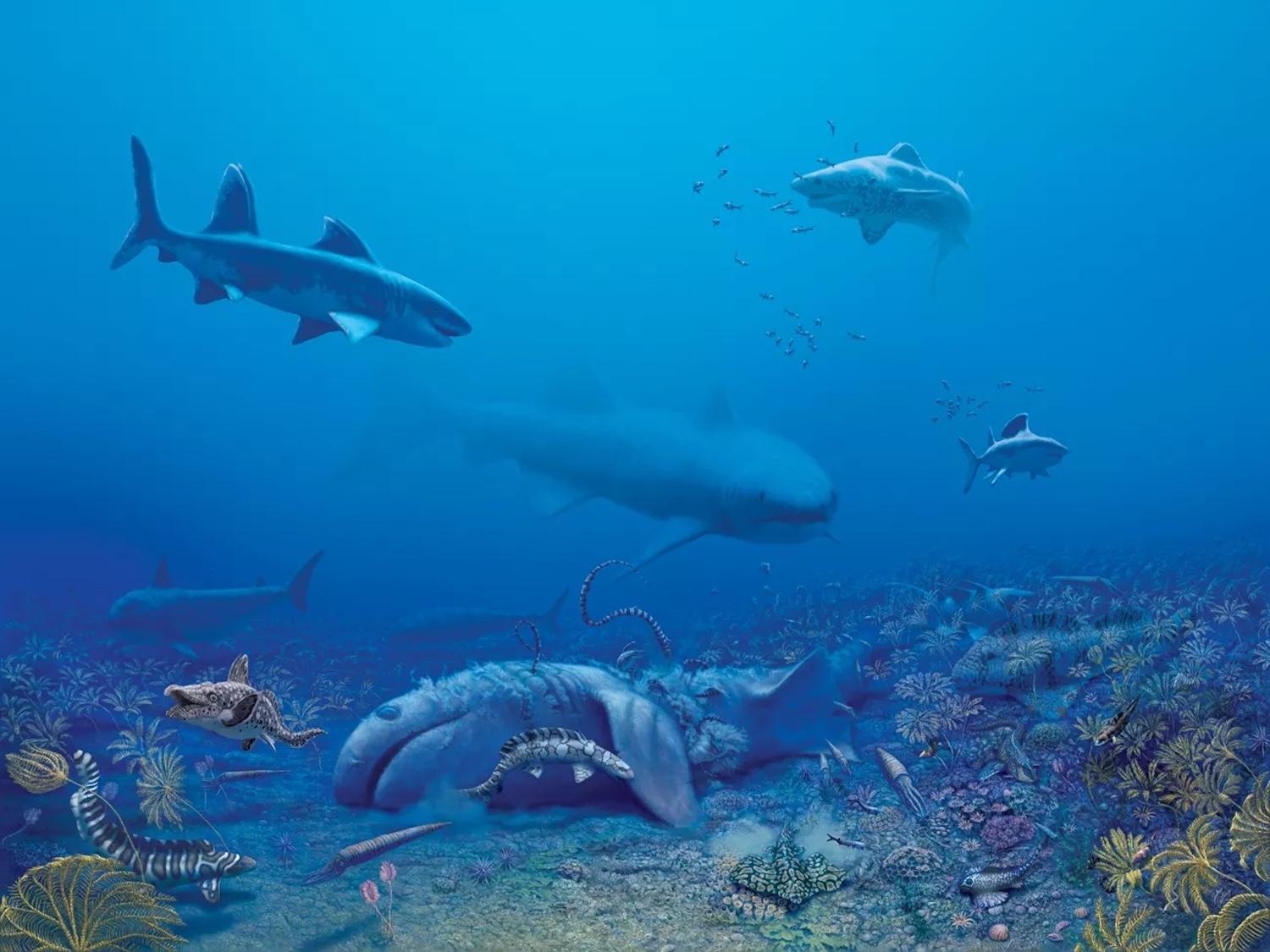
The Mississippian age (325 MYA) ancient sea and marine life preserved at Mammoth Cave National Park/Painting by Julius Csotonyi
Discovering Mammoth Cave’s Oceanic Past
By Kim Kobersmith
At this portal to the underground world cave crickets and salamanders greet us. The passageway is not open to the public, and the only light emanates from our headlamps. But before World War II, Mammoth Cave National Park officials had plans to make this route accessible to visitors, so after we descend the 100+ stairs the passage is easily walkable. My guide, John-Paul Hodnett, calls it the “bunny slope” of new fossil locations he has studied in the cave. The stocky, humble shark paleontologist doesn’t fit the image of a spelunker. In fact he wasn’t, until his work drew him ever deeper into the labyrinthine passages of Mammoth Cave.
As Hodnett and I walk through these untrammeled corridors, he tells me how to spot the fossils in the limestone ceiling.
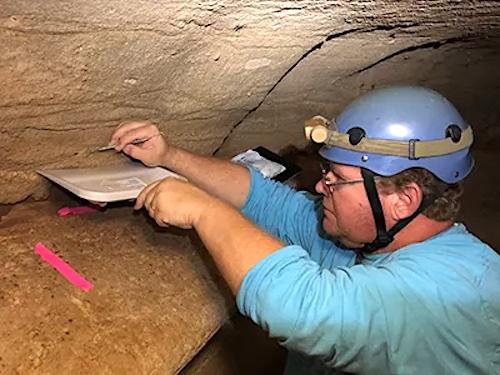
JP Hodnett in Mammoth Cave/NPS
“Look for dark objects, for things that are bizarre,” he said.
Craning my neck to accommodate both my headlamp and bifocals, I begin to see the fossilized remains for myself. First, other creatures that lived in an ancient seaway that covered the landscape known today as Kentucky some 325 million years ago: crinoids, horn coral, brachiopods. Then the small dark slashes that indicate shark teeth. A dorsal fin spine. Then, a large piece of shoulder skeletal cartilage.
“We saw this piece of skeleton on my first trip,” Hodnett explained. “I saw it was three-dimensional and had preserved ridges where the muscles attached and I immediately knew that Mammoth Cave was special.”
He was right.
A Cave Full Of Sharks
The first five years of the national park’s Paleontological Resource Inventory has revealed a treasure trove of fossils from more than 70 species of shark in 25 different locations in the 400+ mile-long cave, including one of the largest sharks to have ever lived and six species that are completely new to science.
But what also awes paleontologists is the sheer number of extremely rare specimens like the shoulder skeleton I saw. More than ten major pieces of skeletal fossils have been identified in the cave, including an almost complete skull above an underground river that has not been fully studied.
Hodnett, an expert in Paleozoic sharks who works part-time for the National Park Service, found his first shark fossil in the Permian limestone campus of Northern Arizona University as a student. His passion sparked, he began scouring campus between classes and on the weekends for more. He tried to explain to me the rarity of the finds inside Mammoth Cave.
“It is ridiculous for one site to have so many fossils that are not teeth, and finding two preserved brain cases is a really big deal,” he said. “For me, it is literally a kid in a candy store situation. It has just been awesome and there is more to come, I am sure.”
This exceptional preservation is attributed to the cave environment. With a constant 54-degree temperature and protection from erosional forces such as ice and wind, it’s ideal for preserving these delicate, ancient piscine time capsules.
The skeletal structure of most sharks is cartilage, not bone, and so is much less likely to fossilize. Hence, most fossilized shark remains found on the surface are teeth and the occasional flattened structural elements. Comparatively, those preserved in Mammoth Cave are large, detailed, and three-dimensional.
The Mammoth Cave inventory has the potential to alter how the National Park Service conducts paleontological surveys.
The fossil record preserved throughout the parks, monuments, and other areas administered by the National Park Service spans at least 1.4 billion years and reveals rich and diverse paleontological resources available for scientific research and public education. Fossils documented in at least 286 different NPS areas represent important and iconic components of the history of North American paleontology. Our knowledge of the fossil record within the national parks continuously expands based on new paleontological discoveries every year. Most of the new fossil discoveries are associated with four primary management activities undertaken by the NPS Paleontology Program, parks, partners, and cooperating scientists: paleontological resource inventories, monitoring, research, and assessment of fossils curated in museum collections. — National Park Service
"The implementation of paleontological resource inventories within the National Park Service has resulted in important new fossil discoveries, helping to expand our understanding of the history of life preserved in the national parks," explained Vincent Santucci, the agency's senior paleontologist and Paleontology Program coordinator. "We will have quite a bit to share over the next year about some of the important fossil discoveries made in the national parks associated with our paleontological resource inventory work."
Until very recently, the known fossil records of Mammoth Cave concentrated on Pleistocene animals: bats, sabertoothed cats, short-faced bear, and mastodon. Park staff knew about an interesting find discovered in the 1990s that appeared to be the jawbone of a marine creature, but they had no idea of its significance until 2018, when Cave Specialist Rick Olson sent some photos of it to Santucci, who in turn showed them to Hodnett. The photos spurred the two to instigate a Paleontological Resource Inventory of the park.
This was Hodnett’s first time to study shark fossils in a cave environment. Leading this research effort since its inception in 2019, he now sees amazing potential for other caves to harbor better-preserved specimens than those found on the surface. How cave passages rise and fall, weaving in and out of different geologic layers, can also reveal new connections between time periods.
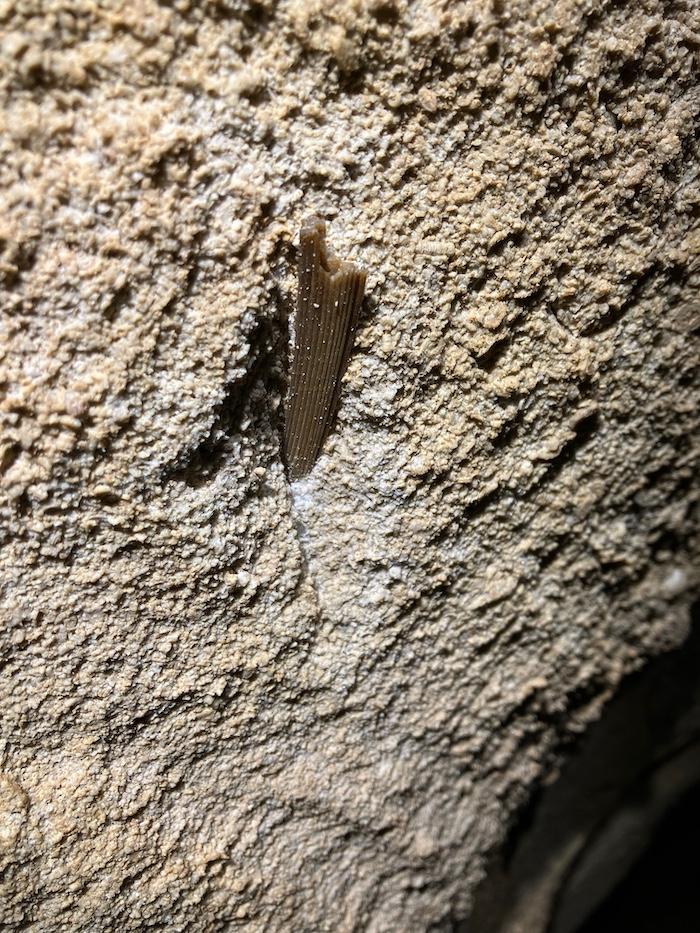
Fossilized shark dorsal fin spine/Kim Kobersmith
An Ancient Seaway
The emerging prolific fossil record is an important scientific benchmark in marine vertebrate paleontology. Much of the original information about North American Mississippian-age sharks (dating from roughly 358 million to 323 million years ago) came out in the late 19th century, some based on a single found tooth. The newly discovered, more complete fossils help define and differentiate species.
For example, the profusion of shark fossils in Mammoth Cave are concentrated in the Ste. Genevieve Formation, a layer of limestone from the Mississippian Period dated at around 325 million years old. While this stratum was known for its invertebrate fossils, the recent discoveries in the national park are the first records anywhere of marine vertebrate fossils. Hodnett said that their findings have inspired others to look with fresh eyes at their own fossil records from that period, and more Ste. Genevieve shark fossils have already been identified in Illinois.
During the Ste. Geneveive epoch, the geologic layer cake that is now Mammoth Cave was the bed of an ancient seaway separating three continents. It pulsed with life, a crinoid “forest” teeming with fish and sharks. As the three continents drifted closer together, forming the super landmass Pangea, this oceanic bed rose until it was no longer underwater. The change caused a die-off of marine species, their remains sinking to the seabed and preserved underground in the resulting rock layers. The flowing water that formed Mammoth Cave cut through this limestone and uncovered the teeth and skeletons, just waiting to be discovered.
“I am absolutely amazed at the diversity of sharks we see while exploring the passages that make up Mammoth Cave,” Hodnett said four years ago when some of the discoveries were announced. “We can hardly move more than a couple of feet as another tooth or spine is spotted in the cave ceiling or wall. We are seeing a range of different species of chondrichthyans [cartilaginous fish] that fill a variety of ecological niches, from large predators to tiny little sharks.”
Studying and Sharing Findings
Discoveries in Mammoth Cave have shed new light on Saivodus striatus, one of the largest sharks to have swum the ancient Mississippian seas. Until recently, knowledge of this species relied on isolated fossilized teeth. Researchers found a partial fossilized skull in the passages of Mammoth Cave with a two-foot-long lower jaw and 1” wide teeth. They believe this shark’s body was 15-16 feet in length, making it larger than today’s great white shark. Even larger teeth found elsewhere in the cave suggest these sharks could grow to a remarkable 20-26 feet in length.
Three of the new species have been named and published. One, Glikmanius careforum, was identified by teeth and a partial set of jaws and gills of a young specimen. Growing to 12 feet in length, its jaw shape suggests it had a short head with a powerful bite for hunting smaller sharks and bony fish. It was named in honor of the Cave Research Foundation, members of which found the fossilized remains. That discovery pushes the origins of the Glikmanius genus back more than 50 million years than previously known.
Hodnett was one of the leading experts for the PRI, but many park rangers, volunteers, and Park Service paleontology staff have contributed to the study. He taught local leaders how to see the telltale signs of new fossils, and volunteer expeditions utilized tools such as black lights to pinpoint them. As they make discoveries, they send pictures to Hodnett, who then determines which fossils should be removed from the cave as crucial samples for analysis and identification of species.
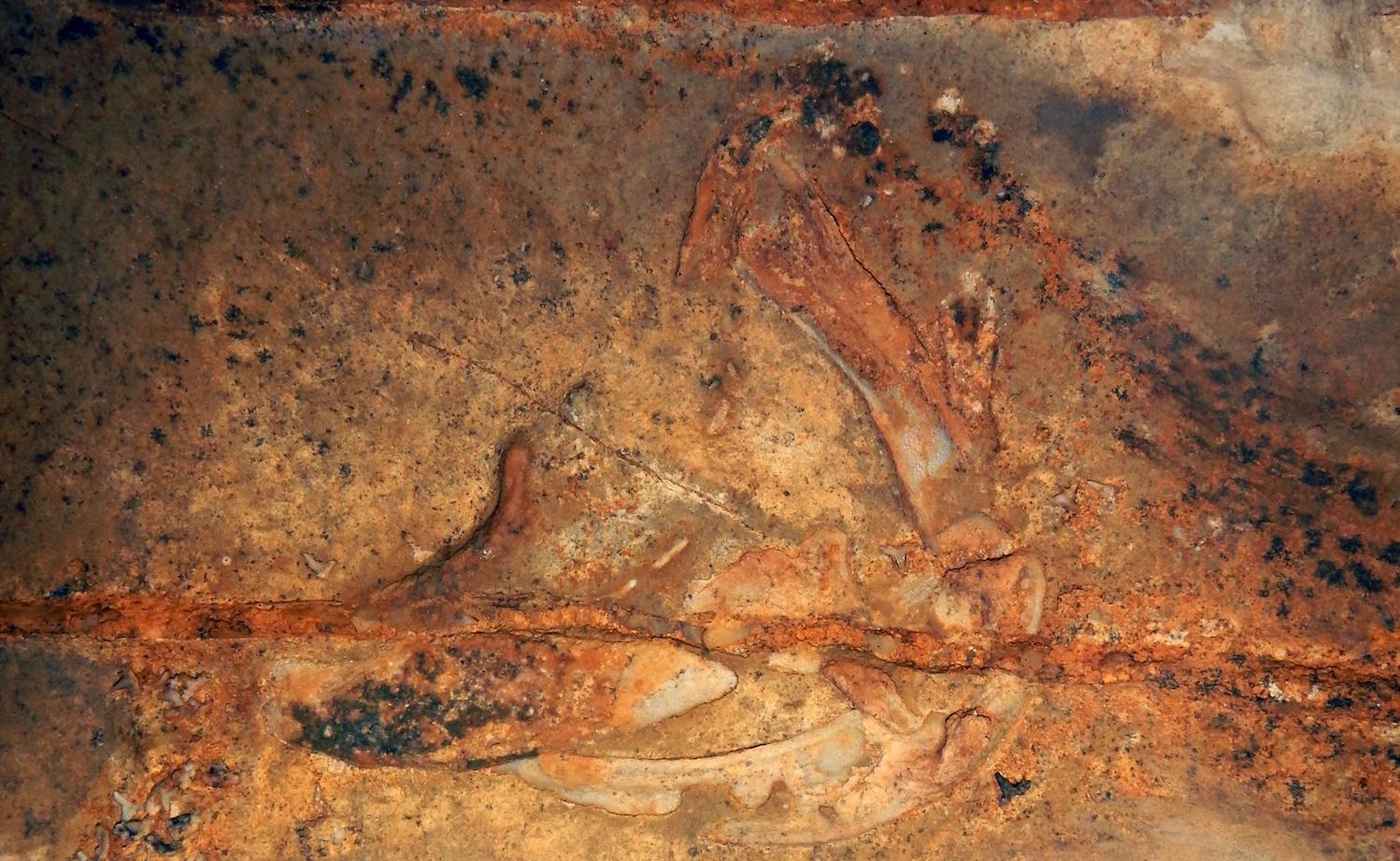
The jaws, teeth, and gills of Glikmanius careforum embedded in the cave ceiling were discovered by Cave Research Foundation explorers during a mapping project/NPS
Most of the hot spots for these marine fossils are not on public cave tours, and reaching some requires advanced spelunking skills (extended crawling on hands and knees, kayaking underground rivers, and descending a narrow borehole by rope). The Park Service is working on several fronts to share these discoveries with visitors.
Using photogrammetric technology, researchers created three-dimensional digital models of two fossilized skeletal pieces. People have enjoyed viewing them through the Mammoth Cave website. Because of the willingness of the Park Service’s Paleontology Program to be open with their data, the models are also utilized by shark experts who, so far, have confirmed the PRI’s findings.
Park staff created other materials for National Fossil Day 2023. Paintings by renowned paleoartist Julius Csotonyi help visitors visualize what life in this sea would have been like. A special display in the park museum highlights one of the other new species, Strigilodus tollesonae, named for park guide Kelli Tolleson, who has spent many hours searching for fossils in the cave’s passages. An enlarged photo of a complete array of teeth fossils provides context for the vials of tiny, spoon-like fossils beneath it. This temporary exhibit will be incorporated into an in-depth display, still under development, in the visitor center museum.
It is hard to contemplate new understandings about life on earth 325 million years ago without getting a bit philosophical. This ancient seabed reminded me that, even though these species are now extinct, life persists, through millions of years, mass extinctions, tectonic shifts, and the formation and dissolution of entire continents.
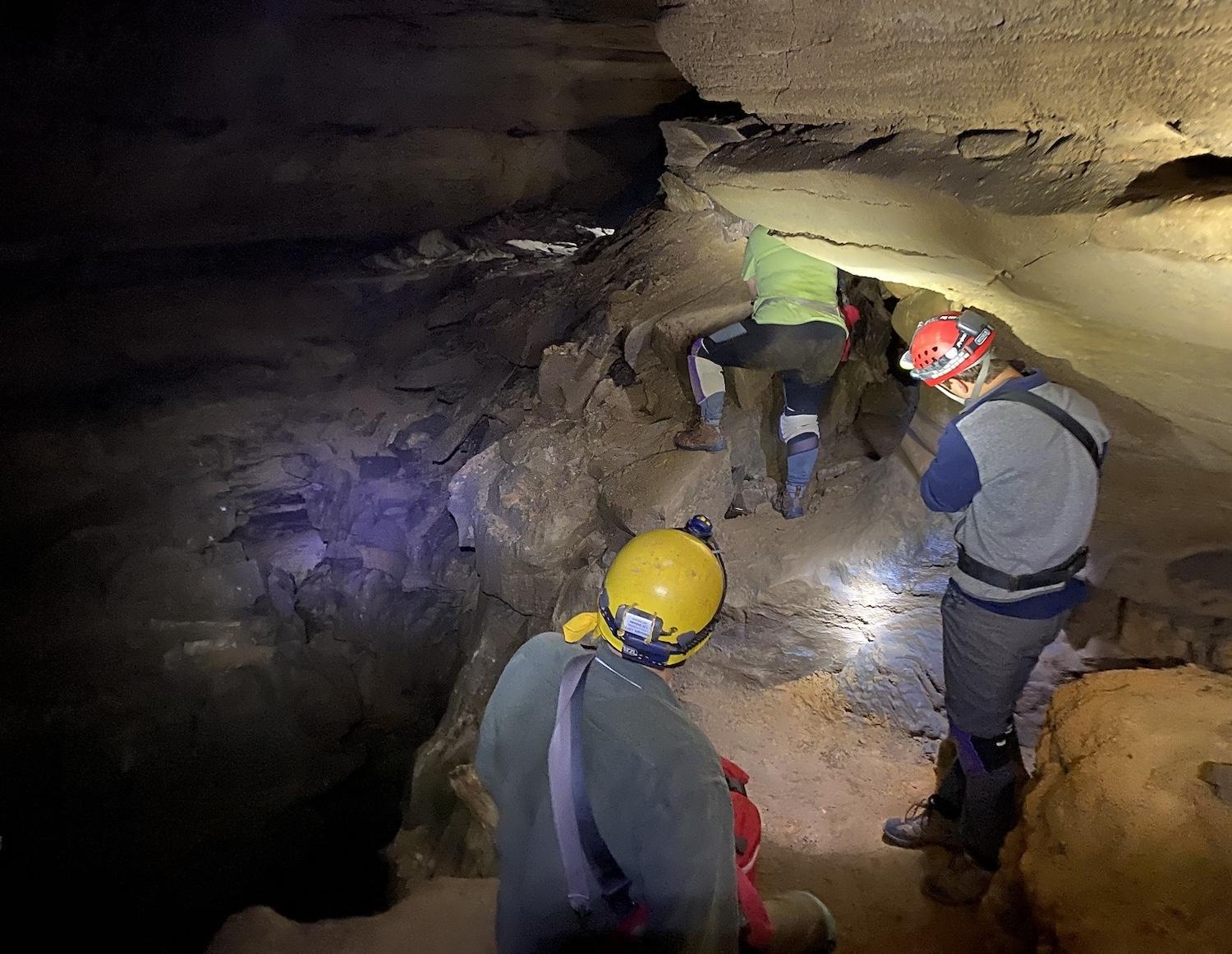
Many important fossil localities in the cave are difficult to get to due to the remote and sometimes challenging passageways. The sites are in areas of low ceilings that require crawling for long distances on hands and knees, and at times, belly crawling/NPS
And something Olson, the retired cave specialist for the park who now volunteers, said during my visit stuck with me: “It took someone knowledgeable like JP to realize what we have here.”
The abundance of fossils and scientific breakthroughs accumulated through this inventory serves as a reminder that there is much we don’t know about the treasures preserved by the Park Service. There is always more to explore, even in parks like Mammoth Cave that have been visited by humans for hundreds of years. What we find might blow our current scientific understandings out of the water.

Comments
Excellent article! It was fun talking with you all as well.ara
Great article. I never knew that sharks and other vertebrates existed in these layers.
Very interesting article, Kim. Makes me want to look closer when I go into caves.